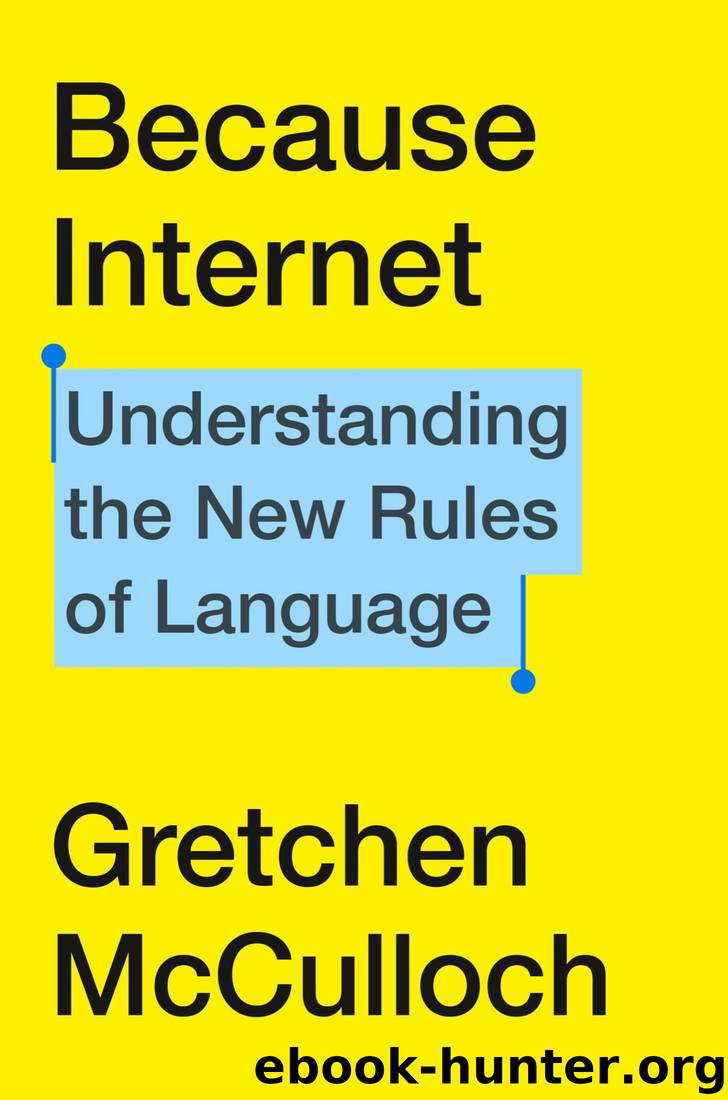Because Internet: Understanding the New Rules of Language by Gretchen McCulloch

Author:Gretchen McCulloch
Language: eng
Format: epub
Publisher: Riverhead Books
Published: 2019-07-22T23:00:00+00:00
19-Sep-82 11:44 Scott E Fahlman :-)
From: Scott E Fahlman <Fahlman at Cmu-20c>
I propose that the following character sequence for joke markers:
:-)
Read it sideways. Actually, it is probably more economical to mark things that are NOT jokes, given current trends. For this, use
:-(
The idea of a simplified smiling face already had a considerable history, so Fahlman’s sideways proposal was straightforward to interpret. It was also easy to type, and was thus quickly picked up by other participants in the message thread, and within a couple months people were using sideways text faces beyond Carnegie Mellon and had come up with a wide variety of creative expansions on the sideways idea, including non-face examples like the heart <3 and the rose @>-->--. Many of the more elaborate examples, like sideways portraits of famous people, circulated more in lists of clever faces than in actual usage. (It’s unclear when a person would ever need to invoke Abraham Lincoln by smiley, but here he is ==(:-)= complete with tall hat and beard.) A few classics like :-) :-( ;-) :’-( :-P, and later their noseless variants :) :( ;) :’( :P, remained the most popular.
Symbols like :-) were named emoticons, a combination of the words “emotion” and “icon.” One useful side effect of emoticons is that they let you incorporate the facial part into your running text, right alongside your words, rather than using a large, unwieldy image that has to go on a new line—even if it’s made out of the same ASCII characters as the rest of your message. Just like gestures and facial expressions fit seamlessly with spoken words, punctuation-based emoticons can directly accompany typed words.
Filling an important niche, the text-based emoticons grew and changed. The meaning of the basic smile shifted after Scott Fahlman’s original proposal, from indicating a joke to indicating a more general positive sentiment, a marker of sincerity: “that’s great :)” is sincere, not sarcastic. The nose fell out of favor among younger people: in 2011, a study of emoticons on Twitter by linguist Tyler Schnoebelen found that noseful emoticons were used by people who also tended to tweet to celebrities like Pepe Aguilar, Ashton Kutcher, and Jennifer Lopez, whereas those who tweeted noseless emoticons tended to prefer to tweet to Justin Bieber, Miley Cyrus, the Jonas Brothers, and Selena Gomez. (For the benefit of readers from the future who don’t have a degree in Early Twenty-First Century American Pop Culture, I’ll point out that Justin Bieber and the like were very popular among teenagers in 2011, while Kutcher, Lopez, et al. were an older set of celebrities. This strongly suggests that younger people were dropping the noses in their emoticons.)
Around the same time as emoticons were developing in the United States and on English-speaking networks, another form of digital face was developing on an early Japanese computer network known as ASCII Net. They were called kaomoji, from the Japanese kao (顔, “face”) and moji (文字, “character”). Kaomoji are like emoticons, but you don’t have to turn
Download
This site does not store any files on its server. We only index and link to content provided by other sites. Please contact the content providers to delete copyright contents if any and email us, we'll remove relevant links or contents immediately.
Sapiens: A Brief History of Humankind by Yuval Noah Harari(14209)
Sapiens by Yuval Noah Harari(5278)
Pale Blue Dot by Carl Sagan(4883)
Homo Deus: A Brief History of Tomorrow by Yuval Noah Harari(4798)
Livewired by David Eagleman(3663)
Origin Story: A Big History of Everything by David Christian(3631)
Brief Answers to the Big Questions by Stephen Hawking(3351)
Inferior by Angela Saini(3259)
Origin Story by David Christian(3131)
Signature in the Cell: DNA and the Evidence for Intelligent Design by Stephen C. Meyer(3053)
The Gene: An Intimate History by Siddhartha Mukherjee(3029)
The Evolution of Beauty by Richard O. Prum(2924)
Aliens by Jim Al-Khalili(2775)
How The Mind Works by Steven Pinker(2713)
A Short History of Nearly Everything by Bryson Bill(2616)
Sex at Dawn: The Prehistoric Origins of Modern Sexuality by Ryan Christopher(2472)
From Bacteria to Bach and Back by Daniel C. Dennett(2432)
Endless Forms Most Beautiful by Sean B. Carroll(2413)
Who We Are and How We Got Here by David Reich(2385)
